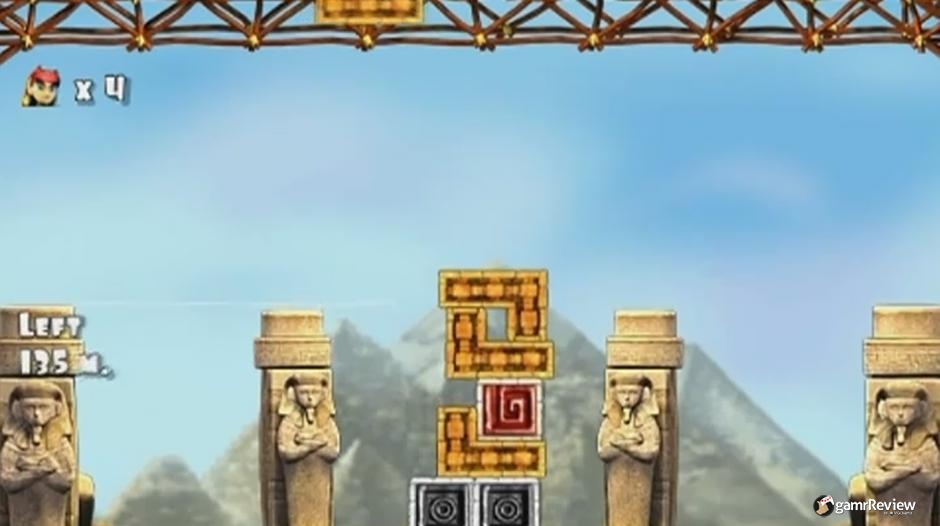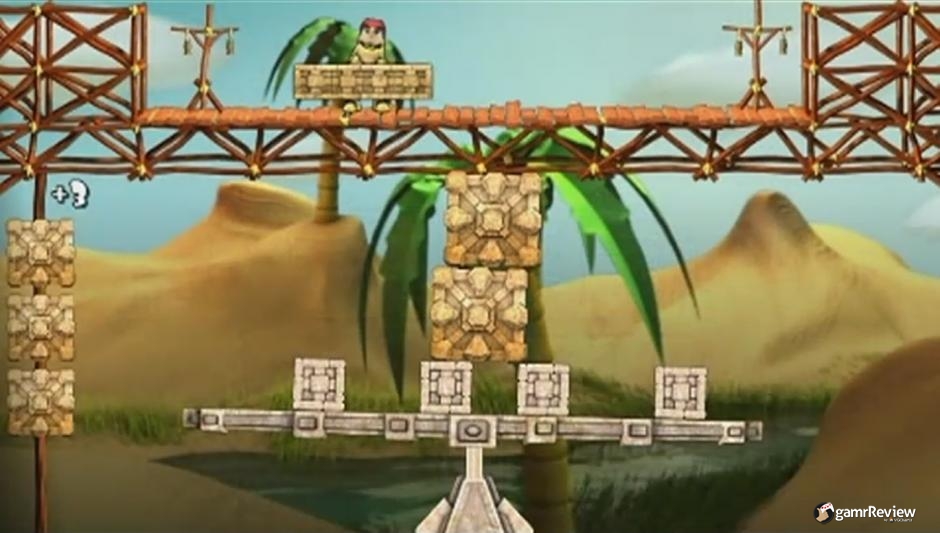
BABEL: The King of the Blocks (PSP) - Review
by Arthur Kabrick , posted on 16 June 2011 / 4,728 ViewsIn a country like Egypt (which apparently is not Egypt, despite the appearance of the characters, the pyramids, the sand, the music and the dancing), without the existence of games or balls in cups, the people are bored. Fortunately, a young man named Babel has a schematic blown into his face, showing an unfinished pyramid, which can apparently be completed by putting a block on top of it. This gives him the brilliant idea of constructing a pyramid, a temple and a tower, by dropping blocks from a bridge. And people say technology hasn’t progressed. Block types include squares, rectangles, triangles, circles and Tetris-style L-shaped blocks, and each block is given to you in turn, and you must place it and drop it.
The construction of each of these three buildings involves playing through several levels with slightly different mechanics. The Great Pyramid requires very little skill or thought, and just involve dropping blocks on a flat platform on a pivot. Drop too many on one side, and it collapses. Build too high, and you break your bridge. You will accomplish more here by randomly dropping blocks, alternating between right and left, than anything else. A good knowledge of moments might help, but on the other hand it might just distract you from side-alternating. It is quite unlikely that you will make it through this section without getting so bored that you stop. Very little changes between stages.

Building a temple is more difficult. This time, there is no balancing involved: you drop the blocks onto a stable platform, but the placing of the blocks is much more important. You often have to make them tessellate to prevent the whole structure from collapsing, which makes you fail the level. Some leeway is given here, but not very much; if you try the Pyramid strategy here, you will fail every time. Because of the thought required here, this was my favourite game mode by far.
Constructing the tower is reminiscent of Tower Blocks. You must drop the blocks on top of one another until you have reached a certain height target. You are allowed to drop a handful of them off the screen, but not very many. This is more about reflexes than long-term planning: the block appears at the top of the screen and hovers for only a few seconds before dropping; if you are not fast enough, you will miss your tower. The game’s inaccurate controls don’t lend themselves very well to this mode, with the result that it is the most difficult of the three.
Each of these modes contains eighteen levels, which must be completed in order. This is the sort of game which would lend itself far better to a free choice of level, due to the absence of a real difficulty curve, so the enforced linearity is a shame. However, only the temple and tower are really worth playing through to the finish, because of the slightly different thought processes involved for different levels, and the latter can be so cheap, you may give up even before the end. This has the result of giving you about an hour playtime, which is quite decent for a Mini, but not great.

There is no single-player free-play mode, unfortunately, and the multiplayer mode, Team Play, is really quite absurd. Player One uses the left and right button to move his block, and Player Two uses Square and Circle. You take it in turns to drop blocks in a manner similar to Tower mode in the single-player, and try to reach as great a height as possible. You could feasibly control both players yourself, because really, who is going to play local multiplayer on a PSP? For this reason, it would have been better if a proper single-player free-play mode were introduced. Perhaps if you happen to be on a bus with a friend and only one PSP, this could keep you amused for a few minutes.
The graphics are nothing to write home about, but not bad for a Mini. The backdrop on each level is unique, which is quite impressive, but they are all Egypt-themed. Everything has the stereotypical Egyptian sandy-brown colour, but some of the visual design on the blocks is quite good. The main character looks pretty pathetic, especially when he does his victory dance at the end of each level, but you don’t spend much time looking at him anyway. The music playing in the background in the Great Pyramid and the Temple (it is the same track for both) is upbeat and interesting, but the background track in the Tower and the multiplayer, which certainly sounded the same, was too quiet. Similarly, sound effects are decent, but they could have been more over-the-top – they are a little subdued.
BABEL is not a particularly memorable game, but then it’s not trying to be. It is a decent experience, and can be a nice distraction on a short journey, but there are better Minis available on PSN. Regardless, if you do like your block-based games, you might want to consider giving BABEL a try.
VGChartz Verdict
6.5
Decent



























